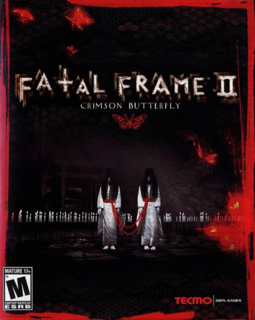Dark Corners
"Fatal Frame II" is a tragic tale of horror, featuring a pair of twins who one day, wander around a forest, only to find themselves trapped in a ghost town, named "All God's Village", which… no longer exists. It's similar, on many levels, to its predecessor, featuring a traditional tale about sacrifice, the upholding of tradition, the respect for higher powers, and its inevitable clash with each individual's spirit and feelings. However, this time around, the story focuses more coherently on the relationship between the main characters (the two siblings), achieving greater emotional impact and depth in characterization. It's post-"ICO" in that way, but whereas in Ueda's masterpiece the love relationship was implied in narrative and deepened through interaction, "Crimson Butterfly" settles with the former. Despite that, putting emotional drive on the forefront of a game is rare, especially considering the delicate nature of "Fatal Frame's" female protagonists.
Exploring "All God's Village" is facing the dark and the oppressive: the dead silence of the surrounding woods is only matched by the decrepit nature of the ancient village, with its crumbling edifices casting their shadows over the scarce moonlight. The dirty halls of the houses pave room for an astonishing mise-en-scéne, with careful lighting patterns illuminating the dark corners of the haunted halls and traditional Japanese decoration establishing the set's mood with consistency and attention to detail. Akira Nishimura, art designer, accomplished a real feat here, by being able to produce such an intricate set, while resorting to a relatively small budget.
However, as is so common in the means, things get fiddly on a purely interactive level. Whilst Makoto Shibata (director) and his "Zero" team show that they've come to understand how traditional Japanese horror works in literature and cinema, they fail in properly adapting its structural form and aesthetic to the interactive dimension. Though "Project Zero II" is, most of the time, a by the numbers, well paced action-adventure game, with simple puzzles and exploration sequences, its main grab comes from its combat system, implemented by the "Camera Obscura", a camera capable of exorcising demons and other-worldly figures. Never mind the verisimilitude of such an item, the bottom line is that it works as a way of putting the player face to face with the ghosts that the game throws at him. And by using the first person perspective, the game heightens the subjective feel of the apparitions, playing with players' tension and making them all the more conscious of the game's protagonist's sensation upon encountering such spirits. However, it seems the game designers thought this game mechanic to be too good to avoid exploring to its fullest, and so, to what was a natural, aesthetically unobtrusive battle system, they added a plethora of game-y interfaces and power ups, not to mention a point driven level up system, as ways to enhance the system's ludic aspects. Suffice to say, they hurt the dramatic core of the game's narrative, and its aesthetic cohesiveness, adding an excessively noisy design layer to what should obviously be a moody experience.
Unlike "Silent Hill", "Fatal Frame" isn't able to come to full fruition as a horror video-game, mostly due to its lack of maturity in the interactive department, with its game-y ideas breaking away the foreboding atmosphere that the art design and soundtrack so laboriously work to achieve. However, "Crimson Butterfly" can still translate to the video-game means most of what makes traditional Japanese Horror unique, by serving as the perfect embodiment of its aesthetic and narrative expression. That is what ultimately allows players to be taken to that unpleasant place to which they dare not go: the dark corners of the human mind, those dark recesses of evil, where fears take the shape of monsters and the dead shadows of the past come back to life… that frightening place where we must face our sins.

